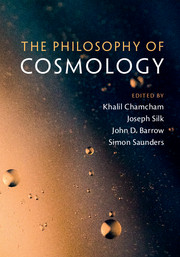Book contents
- Frontmatter
- Contents
- List of Contributors
- Preface
- Acknowledgments
- Part I Issues in the Philosophy of Cosmology
- Part II Structures in the Universe and the Structure of Modern Cosmology
- Part III Foundations of Cosmology: Gravity and the Quantum
- Part IV Quantum Foundations and Quantum Gravity
- Part V Methodological and Philosophical Issues
- 19 Limits of Time in Cosmology
- 20 Self-Locating Priors and Cosmological Measures
- 21 On Probability and Cosmology: Inference Beyond Data?
- 22 Testing the Multiverse: Bayes, Fine-Tuning and Typicality
- 23 A New Perspective on Einstein's Philosophy of Cosmology
- 24 The Nature of the Past Hypothesis
- 25 Big and Small
- Index
- References
23 - A New Perspective on Einstein's Philosophy of Cosmology
from Part V - Methodological and Philosophical Issues
Published online by Cambridge University Press: 18 April 2017
- Frontmatter
- Contents
- List of Contributors
- Preface
- Acknowledgments
- Part I Issues in the Philosophy of Cosmology
- Part II Structures in the Universe and the Structure of Modern Cosmology
- Part III Foundations of Cosmology: Gravity and the Quantum
- Part IV Quantum Foundations and Quantum Gravity
- Part V Methodological and Philosophical Issues
- 19 Limits of Time in Cosmology
- 20 Self-Locating Priors and Cosmological Measures
- 21 On Probability and Cosmology: Inference Beyond Data?
- 22 Testing the Multiverse: Bayes, Fine-Tuning and Typicality
- 23 A New Perspective on Einstein's Philosophy of Cosmology
- 24 The Nature of the Past Hypothesis
- 25 Big and Small
- Index
- References
Summary
Introduction
It has recently been discovered that Einstein once attempted – and subsequently abandoned – a ‘steady-state’ model of the expanding universe (Nussbaumer, 2014a; O'Raifeartaigh, 2014; O'Raifeartaigh et al., 2014). An unpublished manuscript on the Albert Einstein Online Archive (Einstein, 1931a) demonstrates that Einstein explored the possibility of a universe that expands but remains essentially unchanged due to a continuous formation of matter from empty space (Figure 23.1). Several aspects of the manuscript indicate that it was written in the early months of 1931, during Einstein's first trip to California, and the work therefore probably represents Einstein's first attempt at a theoretical model of the cosmos in the wake of emerging evidence for an expanding universe (Nussbaumer, 2014a; O'Raifeartaigh et al., 2014). It appears that Einstein abandoned the idea when he discovered that his steady-state model led to a null solution, as described below.
Many years later, steady-state models of the expanding cosmos were independently proposed by Fred Hoyle, Hermann Bondi and Thomas Gold (Bondi and Gold, 1948; Hoyle, 1948). The hypothesis formed a well-known alternative to ‘big bang’ cosmology for many years (Kragh, 1996, pp. 186–218; North, 1965, pp. 208–22; Nussbaumer and Bieri, 2009, pp. 161–3), although it was eventually ruled out by observations such as the distribution of the galaxies at different epochs and the cosmic microwave background (Kragh, 1996, pp. 318–80, 2007, pp. 201–6; Narlikar, 1988, p. 219).While it could be argued that steady-state cosmologies are of little practical interest now, we find it most interesting that Einstein conducted an internal debate between steady-state and evolving models of the cosmos decades before a similar debate engulfed the cosmological community. In particular, the episode offers several new insights into Einstein's cosmology, from his view of the role of the cosmological constant to his attitude to the question of cosmic origins. More generally, Einstein's exploration of steady-state cosmology casts new light on his philosophical journey from a static, bounded cosmology to the dynamic, evolving universe, and is indicative of a pragmatic, empiricist approach to cosmology.
Historical Context
Following the successful formulation of his general theory of relativity (Einstein, 1915, 1916), Einstein lost little time in applying his new theory of gravity, space and time to the universe as a whole.
- Type
- Chapter
- Information
- The Philosophy of Cosmology , pp. 467 - 485Publisher: Cambridge University PressPrint publication year: 2017



